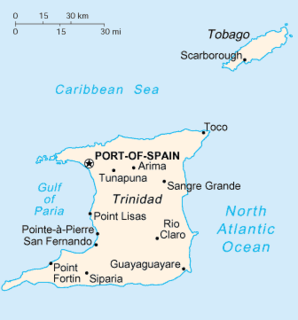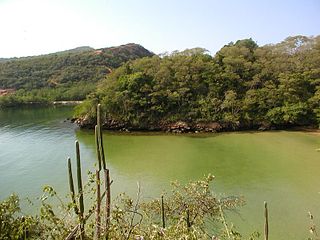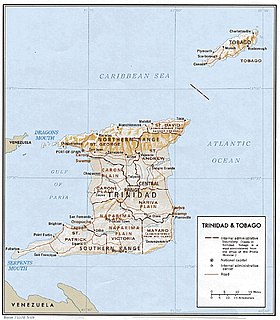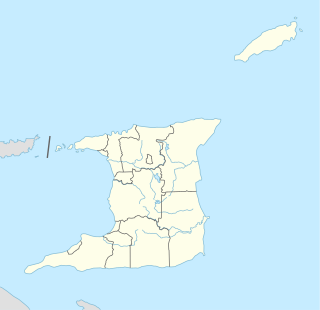
Mayaro is the name of a county on southeastern Trinidad island, in Trinidad and Tobago.
Contents


Mayaro is the name of a county on southeastern Trinidad island, in Trinidad and Tobago.

The "Mayaro District" was the first area of settlement on the east coast. Many estates were granted to French planters who settled Trinidad in the late 18th century. No roads crossed the island and the area was only accessible by steamer until the late 19th century.
The name Mayaro is applied to several villages along the coast. The county of Mayaro occupies a large area of southeastern Trinidad, but the name is usually only applied to the coastal strip. County Mayaro is divided into two wards: Trinity and Guayaguayare.
Along this strip a number of villages exist to which the name Mayaro is generally applied. From north to south these are: Kernaham/Cascadou, Ortoire, St. Joseph, Beau Sejour, Plaisance, Pierreville, Beaumont, St. Ann's, Radix, Ste. Marguerite, Lagon Doux, Grand Lagoon and Lagon Palmiste. Beyond that are several small villages and then the town of Guayaguayare.
Mayaro falls under the jurisdiction of the Rio Claro–Mayaro Regional Corporation. Until 1990 it was administered together with the neighbouring county of Nariva by the Nariva–Mayaro County Council.
Mayaro is also associated with oil production - most of Trinidad's oil and natural gas production comes from offshore oil fields to the east of Mayaro. The major producer is BP Trinidad & Tobago (bpTT), together with BHP Billiton. Onshore oil production is under the control of Petrotrin, although a considerable area has been farmed out to small independent oil producers.

Trinidad and Tobago is an archipelagic republic in the southern Caribbean between the Caribbean Sea and the North Atlantic Ocean, northeast of Venezuela. They are southeasterly islands of the Lesser Antilles, Monos, Huevos, Gaspar Grande, Little Tobago, and St. Giles Island. Trinidad is 11 km (6.8 mi) off the northeast coast of Venezuela and 130 km (81 mi) south of the Grenadines. The island measures 4,768 km2 (1,841 sq mi) in area with an average length of 80 km (50 mi) and an average width of 59 km (37 mi). The island appears rectangular in shape with three projecting peninsular corners. Tobago is 30 km (19 mi) northeast of Trinidad and measures about 298 km2 (115 sq mi) in area, or 5.8% of the country's area, 41 km (25.5 mi) in length and 12 km (7.5 mi) at its greatest width. The island is cigar-shaped in appearance, with a northeast-southwest alignment.

Trinidad is the larger and more populous of the two major islands of Trinidad and Tobago. The island lies 11 km (6.8 mi) off the northeastern coast of Venezuela and sits on the continental shelf of South America. It is often referred to as the southernmost island in the Caribbean. With an area of 5,131 km2 (1,981 sq mi), it is also the fifth largest in the West Indies.

Trinidad and Tobago dry forests are tropical dry forests located primarily in western and southern parts of the island of Trinidad, in southern parts of the island of Tobago and on smaller offshore islands including Chacachacare, Monos, Huevos, Gaspar Grande, Little Tobago and Saint Giles Island.

The Northern Range is the range of tall hills across north Trinidad, the major island in the Republic of Trinidad and Tobago. The hills range from the Chaguaramas peninsula on the west coast to Toco in the east. The Northern Range covers approximately twenty-five percent of the land area of Trinidad.

Guayaguayare is the southeasternmost village in Trinidad and Tobago. It lies at the southern end of the county of Mayaro. Guayaguayare is primarily a fishing village, but it also plays a major role in the petroleum industry. The largest petroleum producers in the country - BP Trinidad & Tobago (bpTT), BHP Billiton and Petrotrin all have major presences here and bpTT controls the Port of Guayaguayare, which services most of the offshore petroleum production in Trinidad. The major natural gas pipelines, serving Atlantic LNG in Point Fortin and the Point Lisas Industrial Estate, come ashore here.

Rio Claro is the largest town in southeastern Trinidad, in Trinidad and Tobago. Rio Claro lies east of Princes Town, west of Mayaro and northwest of Guayaguayare. It serves as the major commercial centre for southeastern Trinidad. It lies in a primarily agricultural area. It is the seat of the Rio Claro–Mayaro Regional Corporation.

Nariva is a county in Trinidad and Tobago. It is located in eastern Trinidad, south of Saint Andrew County and north of Mayaro County, to the west by Victoria County and to the northwest by Saint George County. The southern boundary of the county lies along the Ortoire River and the western boundary is Cocos Bay. The towns of Rio Claro and Ecclesville are located in Nariva County. The Nariva Swamp is located in the eastern part of Nariva County.
Victoria was a county on Trinidad island in Trinidad and Tobago.

Trinidad and Tobago, officially the Republic of Trinidad and Tobago, is the southernmost island country in the Caribbean and is known for its fossil-fuel wealth. Consisting of the main islands Trinidad and Tobago, and numerous much smaller islands, it is situated 130 kilometres south of Grenada and 11 kilometres off the coast of northeastern Venezuela. It shares maritime boundaries with Barbados to the northeast, Grenada to the northwest, Guyana to the southeast, and Venezuela to the south and west.

Couva–Tabaquite–Talparo is one of the 9 regions of Trinidad and Tobago, and one of the five regions which form Gulf of Paria coastline on Trinidad's West Coast. Its regional capital and commercial center is Couva. Couva–Tabaquite–Talparo is the third-largest of Trinidad and Tobago's 9 regions, with an area of 723 square kilometres (300 sq mi). As of 2011, the population was 178,410. The region is the second-most populous and fourth-least-densely populated region in Trinidad with 247 inhabitants per square kilometre (640/sq mi).

Mayaro–Rio Claro is a region of Trinidad. The local government body is Mayaro–Rio Claro Regional Corporation, a Regional Corporation of Trinidad and Tobago. The region has a land area of 852.81 km². The Mayaro–Rio Claro Regional Corporation is headquartered in Rio Claro. Other towns include Mayaro. The region possesses many beach front properties and Trinidad's largest reservoir of natural gas and crude oil along its eastern coast.

Biche is a village in east Trinidad and Tobago 18 kilometers south of Sangre Grande and 18 kilometers north of Rio Claro.

The Ortoire River is a river in Trinidad and Tobago. It forms the boundary between Nariva County and Mayaro County in east Trinidad.

Mayaro Bay stretches for nine miles on the east coast of the island of the Republic of Trinidad and Tobago. The beach which lines the bay, Mayaro Beach, is a popular destination for holidays, long weekends, and is one of the traditional places to spend the Easter holidays. Not only do beach-goers swim, but they also kayak, bird watch, camp, and occasionally kite surf, making Mayaro a tourist hot spot. Located at the southern end of Manzanilla Beach, Trinidad and Tobago, one can reach Mayaro Beach by traveling along the Mayaro–Guayaguayare road or the Mayaro–Naparima road.
Mayaro may refer to:

On the island of Trinidad, the Nariva Plain is a lowland area on the east between the Central Range and the Southern Range; the lowland area on the west is the Naparima Plain. To the north of the Central Range is the Caroni Plain. The lowland areas are either flat or consist of gently rolling hills. The eastern half of the island not as thickly settled as the western. The 35-mile long Ortoire river flows eastward through the Nariva Plain and drains in the Nariva Swamp on the Atlantic Ocean coast.

On the island of Trinidad in the Republic of Trinidad and Tobago, the Caroni Plain is a lowland area between the Northern Range and the Central Range. The lowland areas to the south of the Central Range are the Naparima Plain on the west and the Nariva Plain on the east. The lowland areas are either flat or consist of gently rolling hills. The 25-mile long Caroni river flows westward through the Caroni Plain and drains into the Caroni Swamp on the Gulf of Paria coast. The Caroni Plain was a major region of sugar and cocoa production in the 18th and 19th centuries and the first half of the 20th century.

On the island of Trinidad, the Southern Range is a discontinuous chain of low hills along the southern coast, reaching their highest altitude in the 1,000 feet (300 m) high Trinity Hills of the southeast. According to legend, the sight of the three neighboring hilltops of the then unnamed Trinity Hills, led to Christopher Columbus, on his third voyage to the New World, to name the island, "Trinidad." The broad lowland area on the west between the Southern Range and the Central Range is the Naparima Plain; the lowland area on the east is the Nariva Plain. The Oropuche river flows through the Naparima Plain and drains into the Oropuche Lagoon, a swampy area, on the Gulf of Paria coast, whereas the 31-mile long Ortoire River flows through the Nariva Plain and drains into the Nariva Swamp on the Atlantic Ocean coast. The Southern region of the island has sandy and less fertile soil. The Southern Range, particularly its Western and Central parts, consists of unconsolidated segments.
Ortoire, in Trinidad, is the archeological type site for the Ortoiroid people, immigrants to the Antilles around 2000 BCE.